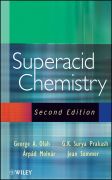
The chemistry of superacids (acid systems stronger than conventional strong mineral Brønsted acids such as sulfuric acid or Lewis acids like aluminum trichloride) has developed in the last two decades into a field of growing interestand importance. It was J. B. Conant who in 1927 gave the name superacids to acids that were capable of protonating certain weak bases such as carbonyl compounds and called attention to acid systems stronger than conventional mineral acids. The realization that Friedel-Crafts reactions are, in general, acid catalyzed with conjugate Lewis-Brønsted acid systems frequently acting as the de facto catalysts extended the scope of acid-catalyzed reactions. The development in the early 1960s of Magic Acid, fluoroantimonic acid, and related conjugate superacids added a new dimension to and revival of interest in superacids and their chemistry. The initial impetus was given by the discovery that stable,long-lived, electron-deficient cations, such as carbocations, acidic oxonium ions, halonium ions, and halogen cations can be obtained in these highly acidic systems. Subsequent work opened up new vistas of chemistry and a fascinating, broad field of chemistry is developing at superacidities. Because acidity isa term related to a reference base, superacidity allows extension of acid-catalyzed reactions to very weak bases and thus extends, for example, hydrocarbonchemistry to saturated systems including methane.
- ISBN: 978-0-471-59668-4
- Editorial: John Wiley & Sons
- Encuadernacion: Cartoné
- Páginas: 850
- Fecha Publicación: 10/03/2009
- Nº Volúmenes: 1
- Idioma: Inglés
